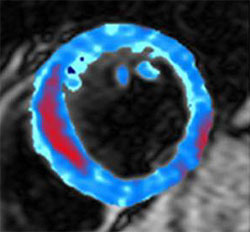LONDON, Jan. 21, 2009 – Images now reveal bleeding that occurs within the heart after a patient has suffered a heart attack. The extent of the bleeding can indicate how severely the heart is damaged.
Researchers from MRC Clinical Sciences Centre at Imperial College London hope that this kind of imaging will be used alongside other tests to create a broader picture of a patient’s condition and his chances of recovery.
Heart attacks occur when an artery that feeds blood to the heart becomes blocked, stopping the heart’s blood supply and depriving the heart muscle of oxygen. The current treatment for this is to fit a patient with a metal tube called a stent, which keeps the blocked artery clear.

The colored area on this MRI scan shows a cross section of the heart muscle, with the area of bleeding shown in red. Image courtesy of Imperial College London.
Recent research has shown that some people experience bleeding inside the heart muscle once blood starts to pump into it again. However, the significance of this bleeding is not understood.
For the small study, the researchers used magnetic resonance imaging (MRI) to capture images of bleeding inside the heart of 15 patients at Imperial College Healthcare NHS Trust who had recently suffered a heart attack. Analysis of the scans revealed that the amount of bleeding correlated with how much damage the heart muscle had sustained.
Patients who had suffered a large heart attack that damaged much of the heart muscle had more bleeding into the heart muscle compared with patients whose heart attack was relatively small.
The magnetic effects of the iron that is present in blood enabled the researchers to detect the areas of bleeding with MRI.
“Our study gives us new insight into the damage that heart attacks can cause. Using this new scanning technique shows us that patients who develop bleeding inside their damaged heart muscle have a much poorer chance of recovery,” said Declan O’Regan, the first and corresponding author of the study. “We hope that this will help us to identify which patients are at high risk of complications following their heart attack.”
“We still have a lot of unanswered questions about whether the bleeding itself may cause further damage to the heart muscle, and this is an area that needs further research,” added Stuart Cook, the study’s senior author. “The more we understand about what happens during and after a heart attack, the greater the chances are of scientists finding new ways to combat the damage that heart attacks cause.”
The research was funded by the Medical Research Council, the British Heart Foundation and the UK Department of Health.
For more information, visit: www.imperial.ac.uk